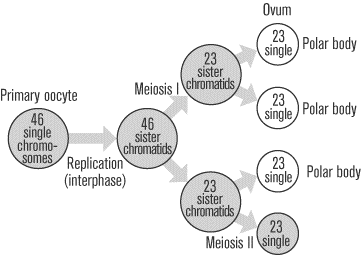Compare and Contrast Oogenesis and Spermatogenesis......
Spermatogenesis and Oogenesis
Meiosis, the process by which gametes are formed, can also be called gametogenesis, literally “creation of gametes.” The specific type of meiosis that forms sperm is called spermatogenesis, while the formation of egg cells, or ova, is called oogenesis. The most important thing you need to remember about both processes is that they occur through meiosis, but there are a few specific distinctions between them.
Spermatogenesis
The male testes have tiny tubules containing diploid cells called spermatogonium that mature to become sperm. The basic function of spermatogenesis is to turn each one of the diploid spermatogonium into four haploid sperm cells. This quadrupling is accomplished through the meiotic cell division detailed in the last section. During interphase before meiosis I, the spermatogonium’s 46 single chromosomes are replicated to form 46 pairs of sister chromatids, which then exchange genetic material through synapsis before the first meiotic division. In meiosis II, the two daughter cells go through a second division to yield four cells containing a unique set of 23 single chromosomes that ultimately mature into four sperm cells. Starting at puberty, a male will produce literally millions of sperm every single day for the rest of his life.
Oogenesis
Just like spermatogenesis, oogenesis involves the formation of haploid cells from an original diploid cell, called a primary oocyte, through meiosis. The female ovaries contain the primary oocytes. There are two major differences between the male and female production of gametes. First of all, oogenesis only leads to the production of one final ovum, or egg cell, from each primary oocyte (in contrast to the four sperm that are generated from every spermatogonium). Of the four daughter cells that are produced when the primary oocyte divides meiotically, three come out much smaller than the fourth. These smaller cells, called polar bodies, eventually disintegrate, leaving only the larger ovum as the final product of oogenesis. The production of one egg cell via oogenesis normally occurs only once a month, from puberty to menopause.

So I was reading through the textbook, trying to get a good handle on the processes of oogenesis and spermatogenesis. Theres alot of information involved in these two processes, so I went online to see what else I could find whether it be a comparative chart or a video etc. I ended up putting this chart together after doing quite a few reviews of the information. After the time spent reading and the time spent online I basically came to one conclusion.... NATURALLY IT TAKES FOUR MEN (OR MALE PARTS) TO DO WHAT ONE WOMAN CAN DO!!!!!!
Oogenesis and Spermatogenesis – Comparative Chart
OOGENESIS |
|
SPERMATOGENESIS |
Oogonium Female germ cell |
| Spermatogonium Male germ cell |
↓
| Germ cells committed to Meiosis | ↓ |
Primary Oocyte
|
| Primary Spermatocyte |
↙↘
| First Meiotic Division | ↙↘ |
Secondary First Oocyte Polar Body |
| Secondary Secondary Spermatocyte Spermatocyte |
↙↘
| Second Meiotic Division | ↙↘ ↙↘ |
Ovum and Second Polar Body
|
| 4 Spermatids |
|
| Spermiogenesis |
1 Ovum 1 viable gamete |
| 4 Spermatazoa 4 viable gametes |


